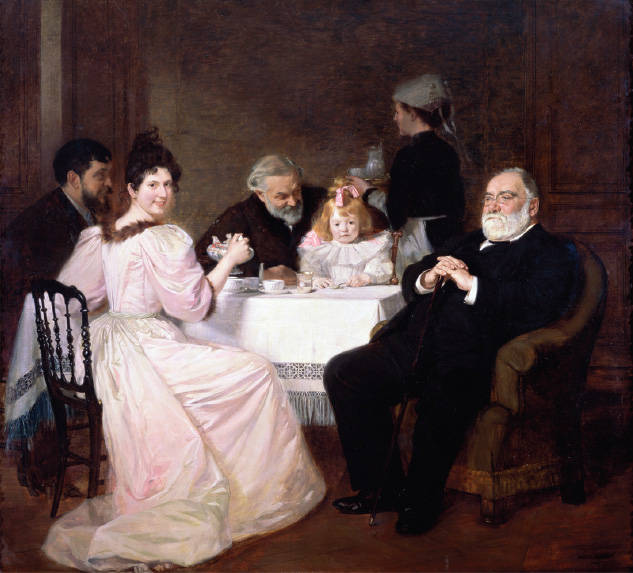The Middle Classes
Change
Question
How did Britain’s middle classes change during the nineteenth century?
[Answer Question]
Those who benefited most conspicuously from industrialization were members of that amorphous group known as the middle class. At its upper levels, this middle class contained extremely wealthy factory and mine owners, bankers, and merchants. Such rising businessmen readily assimilated into aristocratic life, buying country houses, obtaining seats in Parliament, sending their sons to Oxford or Cambridge University, and gratefully accepting titles of nobility from Queen Victoria.
Far more numerous were the smaller businessmen, doctors, lawyers, engineers, teachers, journalists, scientists, and other professionals required in any industrial society. Such people set the tone for a distinctly middle-class society with its own values and outlooks. Politically they were liberals, favoring constitutional government, private property, free trade, and social reform within limits. Their agitation resulted in the Reform Bill of 1832, which broadened the right to vote to many men of the middle class, but not to middle-class women. Ideas of thrift and hard work, a rigid morality, and cleanliness characterized middle-class culture. The central value of that culture was “respectability,” a term that combined notions of social status and virtuous behavior. Nowhere were these values more effectively displayed than in the Scotsman Samuel Smiles’s famous book Self-Help, published in 1859. Individuals are responsible for their own destiny, Smiles argued. An hour a day devoted to self-improvement “would make an ignorant man wise in a few years.” According to Smiles, this enterprising spirit was what distinguished the prosperous middle class from Britain’s poor. The misery of the poorer classes was “voluntary and self-imposed—the results of idleness, thriftlessness, intemperance, and misconduct.”19 (See Document 17.3 for an excerpt from Smiles’s writings.)
Women in such middle-class families were increasingly cast as homemakers, wives, and mothers, charged with creating an emotional haven for their men and a refuge from a heartless and cutthroat capitalist world. They were also expected to be the moral centers of family life, the educators of “respectability,” and the managers of household consumption as “shopping”—a new concept in eighteenth-century Britain—became a central activity for the middle classes. An “ideology of domesticity” defined homemaking, child rearing, charitable endeavors, and “refined” activities such as embroidery, music, and drawing as the proper sphere for women, while paid employment and public sphere of life outside the home beckoned to men.

Male elites in many civilizations had long established their status by detaching women from productive labor. The new wealth of the Industrial Revolution now allowed larger numbers of families to aspire to that kind of status. With her husband as “provider,” such a woman was now a “lady.” “She must not work for profit,” wrote the Englishwoman Margaretta Greg in 1853, “or engage in any occupation that money can command.”20 Employing even one servant became a proud marker of such middle-class status. But the withdrawal of middle-class women from the labor force turned out to be only a temporary phenomenon. By the late nineteenth century, some middle-class women began to enter the teaching, clerical, and nursing professions, and in the second half of the twentieth century, educated middle-class women flooded into the labor force. By contrast, the withdrawal of children from productive labor into schools has proved a more enduring phenomenon as industrial economies increasingly required a more educated workforce.
As Britain’s industrial economy matured, it also gave rise to a sizable lower middle class, which included people employed in the growing service sector as clerks, salespeople, bank tellers, hotel staff, secretaries, telephone operators, police officers, and the like. By the end of the nineteenth century, this growing segment of the middle class represented about 20 percent of Britain’s population and provided new employment opportunities for women as well as men. In just twenty years (1881–1901), the number of female secretaries in Britain rose from 7,000 to 90,000. Almost all were single and expected to return to the home after marriage. Telephone operators had initially been boys or men, but by the end of the nineteenth century in both Britain and the United States that work had become a wholly female occupation. For both men and women, such employment represented a claim on membership in the larger middle class and a means of distinguishing themselves clearly from a working class tainted by manual labor.